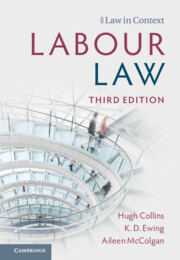Refine search
Actions for selected content:
263 results
7 - Settler Labour Poetics and the National Imaginary at the Turn of the Twentieth Century
-
-
- Book:
- The Cambridge History of Australian Poetry
- Published online:
- 19 November 2025
- Print publication:
- 11 December 2025, pp 137-149
-
- Chapter
- Export citation
LABOUR AND STATUS IN CLASSICAL ATHENS: THE CASE OF THE UNSPECIALIZED WAGE-LABOURER
-
- Journal:
- The Classical Quarterly , First View
- Published online by Cambridge University Press:
- 27 November 2025, pp. 1-8
-
- Article
-
- You have access
- Open access
- HTML
- Export citation
16 - The Soviet War Effort
- from Part V - Home Fronts
-
-
- Book:
- The Cambridge Companion to the Nazi-Soviet War
- Published online:
- 13 November 2025
- Print publication:
- 20 November 2025, pp 281-298
-
- Chapter
- Export citation
Chapter 5 - Uterine Contractions
-
-
- Book:
- Best Practice in Labour and Delivery
- Published online:
- 16 October 2025
- Print publication:
- 06 November 2025, pp 57-70
-
- Chapter
- Export citation
Chapter 1 - Pelvic and Fetal Cranial Anatomy and the Stages and Mechanism of Labour
-
-
- Book:
- Best Practice in Labour and Delivery
- Published online:
- 16 October 2025
- Print publication:
- 06 November 2025, pp 1-13
-
- Chapter
- Export citation
Chapter 22 - Preterm Birth
-
-
- Book:
- Best Practice in Labour and Delivery
- Published online:
- 16 October 2025
- Print publication:
- 06 November 2025, pp 272-284
-
- Chapter
- Export citation
Transformative just transition as redistribution of income and wealth
-
- Journal:
- The Economic and Labour Relations Review ,
- Published online by Cambridge University Press:
- 20 October 2025, pp. 1-15
-
- Article
-
- You have access
- Open access
- HTML
- Export citation
Chapter 5 - The Dialectic of Economic Freedom
- from Part II - Hegel Beyond Liberalism
-
- Book:
- Hegel Beyond Liberalism
- Published online:
- 27 September 2025
- Print publication:
- 16 October 2025, pp 130-188
-
- Chapter
- Export citation
Chapter 16 - Lithium in the Web of Life
- from Part III - Applications
-
-
- Book:
- Commodities and Literature
- Published online:
- 14 October 2025
- Print publication:
- 09 October 2025, pp 278-297
-
- Chapter
- Export citation

Labour Law
-
- Published online:
- 02 October 2025
- Print publication:
- 20 November 2025
-
- Textbook
- Export citation
“Slavery-Free”: Labour at the Todos os Santos Factory (Bahia, ca. 1840–1870)
-
- Journal:
- Itinerario / Volume 49 / Issue 2 / August 2025
- Published online by Cambridge University Press:
- 24 September 2025, pp. 336-356
-
- Article
-
- You have access
- Open access
- HTML
- Export citation
Conclusion
-
- Book:
- Maritime Relations
- Published online:
- 23 August 2025
- Print publication:
- 04 September 2025, pp 182-186
-
- Chapter
- Export citation
Getting into ancient barbers’ hair: new perspectives on barbers in the Greek East
-
- Journal:
- The Journal of Hellenic Studies , First View
- Published online by Cambridge University Press:
- 22 August 2025, pp. 1-20
-
- Article
- Export citation
WHO MAKES THE PESTO? LABOUR, SOCIAL STATUS AND AUTHORSHIP IN THE MORETVM
-
- Journal:
- The Classical Quarterly , First View
- Published online by Cambridge University Press:
- 15 August 2025, pp. 1-15
-
- Article
-
- You have access
- Open access
- HTML
- Export citation
Chapter 10 - Karl Marx
-
- Book:
- Freedom and Perfection
- Published online:
- 25 July 2025
- Print publication:
- 14 August 2025, pp 284-318
-
- Chapter
- Export citation
48 - The Economy of the Later Roman Empire
- from Part V - Issues and Debates
-
- Book:
- The Cambridge Encyclopaedia of Late Antique Art and Archaeology
- Published online:
- 04 July 2025
- Print publication:
- 31 July 2025, pp 839-856
-
- Chapter
- Export citation
The Labour Vote Revisited: Impacts of Union Type and Demographics on Electoral Behaviour in Canadian Federal Politics
-
- Journal:
- Canadian Journal of Political Science/Revue canadienne de science politique / Volume 58 / Issue 3 / September 2025
- Published online by Cambridge University Press:
- 18 July 2025, pp. 642-665
-
- Article
-
- You have access
- Open access
- HTML
- Export citation
Chapter 1 - Dublin
- from Part I - Key Places and Events
-
-
- Book:
- Sean O'Casey in Context
- Published online:
- 23 June 2025
- Print publication:
- 10 July 2025, pp 9-21
-
- Chapter
- Export citation
Chapter 7 - Class
- from Part II - Social Contexts
-
-
- Book:
- Sean O'Casey in Context
- Published online:
- 23 June 2025
- Print publication:
- 10 July 2025, pp 79-88
-
- Chapter
- Export citation
Chapter 38 - Revisionism
- from Part VI - Critical Understandings
-
-
- Book:
- Sean O'Casey in Context
- Published online:
- 23 June 2025
- Print publication:
- 10 July 2025, pp 413-422
-
- Chapter
- Export citation
